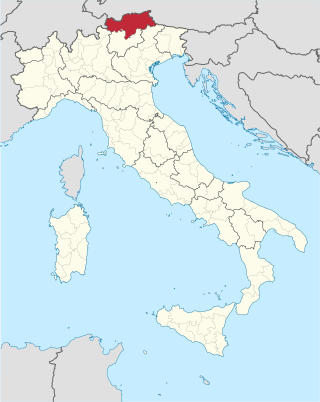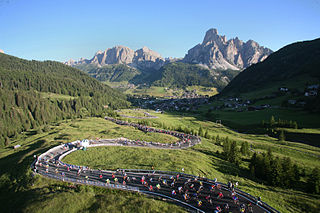
Ladin is a Romance language of the Rhaeto-Romance subgroup, mainly spoken in the Dolomite Mountains in Northern Italy in the provinces of South Tyrol, Trentino, and Belluno, by the Ladin people. It exhibits similarities to Romansh, spoken in Switzerland, as well as Friulian, spoken in north-east Italy.

South Tyrol is an autonomous province in Northern Italy. An English translation of the official German and Italian names could be the Autonomous Province Bolzano - South Tyrol. Together with the Autonomous Province of Trento it forms the autonomous region Trentino-Alto Adige/Südtirol. The province is the northernmost of Italy, the second largest, with an area of 7,400 square kilometres (2,857 sq mi) and has a total population of about 534,000 inhabitants as of 2021. Its capital and largest city is Bolzano.

Trentino, officially the Autonomous Province of Trento, is an autonomous province of Italy, in the country's far north. Trentino and South Tyrol constitute the region of Trentino-Alto Adige/Südtirol, an autonomous region under the constitution. The province is composed of 166 comuni (municipalities). Its capital is the city of Trento (Trent). The province covers an area of more than 6,000 km2 (2,300 sq mi), with a total population of 541,098 in 2019. Trentino is renowned for its mountains, such as the Dolomites, which are part of the Alps.

Bruneck is the largest town in the Puster Valley in the Italian province of South Tyrol.

Badia is a comune (municipality) in South Tyrol, northern Italy. It is one of the five Ladin-speaking communities of the Val Badia which is part of the Ladinia region.

Kastelruth is a comune (municipality) and a village in South Tyrol in northern Italy, about 20 kilometres (12 mi) northeast of the city of Bolzano. It is a member of the I Borghi più belli d'Italia association.

Mareo is a comune (municipality) in South Tyrol in northern Italy, located about 50 kilometres (31 mi) northeast of Bolzano.

The Campolongo Pass (1875 m) is a high mountain pass in the Dolomites in South Tyrol in Italy.

Gardena Pass is a high mountain pass in the Dolomites of the South Tyrol in northeast Italy.

The Karerpass (1745 m) is a high mountain pass in the province of South Tyrol in Italy. It connects Bolzano through the Eggental and the Welschnofen Valley with the Fassa Valley. Just below the pass on the Welschnofen Valley side is the Karersee lake. It is connected to the Tierser Tal by the Nigerpass.

The Sella Pass (2218 m) is a high mountain pass between the provinces of Trentino and South Tyrol in Italy.

The South Tyrol Alpine Club, abbreviated AVS, is an association of German and Ladin-speaking mountain climbers in South Tyrol, northern Italy. Founded in 1946, it is subdivided into 32 sections and 58 local divisions. The AVS is based in Bolzano and has more than 60,000 members.

The Kronplatz is a mountain of the Dolomites in South Tyrol, northern Italy, with a summit elevation of 2,275 metres (7,464 ft) above sea level.

Langkofel is the highest mountain of the Langkofel Group in the Dolomites in South Tyrol, Italy. The name translates to "long peak" / "long rock" in all three languages. It stands over the Ladin community of Val Gardena.

The Peitlerkofel is a mountain of the Dolomites in South Tyrol, Italy. A solitary mountain, it stands between Val Badia to the east and the Villnöß valley to the west, in the very north of the Dolomites. It boasts two distinct summits, the Grosser Peitler (2875m) and the Kleiner Peitler (2813m), which are divided by a deep ridge.

The Seekofel is a mountain in the Dolomites on the border between South Tyrol and the Province of Belluno, Italy.

The Vigiljoch is a mountain pass near Lana in South Tyrol, Italy. The pass is at elevation 1,743 m, whereas the nearby summits northeast of the pass are insignificantly higher.

The Zehner is a mountain near La Val in South Tyrol, Italy.

The Pfitscherjoch is a mountain pass in the Zillertal Alps on the border between Tyrol, Austria, and South Tyrol, Italy.

Ladinia is a neologism used to describe an Alpine region in the Dolomites mountain range of Northern Italy, divided between the Italian provinces of Belluno, South Tyrol, and Trento. The area takes its name from its inhabitants, the Ladin people, a Romance-speaking ethnic group. Their Ladin language is generally considered a Rhaeto-Romance language, though there is a scientific debate if it forms part of a wider northern Italian dialect continuum.





















